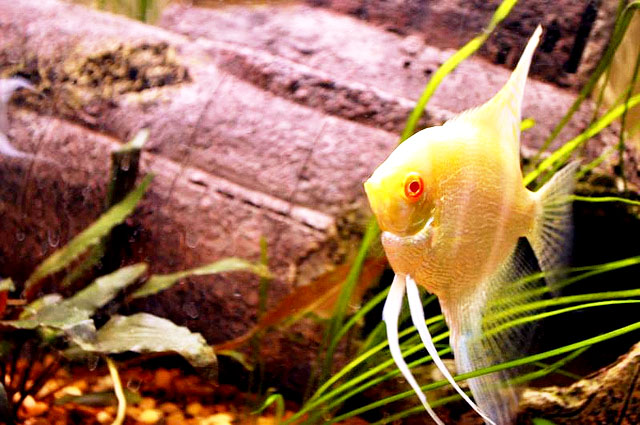
Many varieties of selectively bred angelfish (Pterophyllum) are available, which have variations in the nine basic colors. One of the different types of angelfish is the Albino Pearlscale Angelfish. As seen in the fish pictures below, if Pterophyllum Altum Angelfish identified by its brown vertical stripes over a silver body. The Albino Angel is a strain of angelfish that is white to silver in color with yellow/orange coloration across the head and has red eyes.

Albino Angelfish is a very easy to maintain aquarium fish. It can be found in every aquarium pet shop and prefers a well-planted tank of at least 30 gallons with soft, slightly acidic water. Rocks and driftwood can be added to the aquarium, but leave plenty of space for swimming.
It is best, when trying to breed the Freshwater Angelfish, to house a number of angels in the same aquarium until they pair off. After a pair has developed, a flat surface needs to be provided where the eggs can be laid. A piece of slate, a large plant leaf, or even a flowerpot should be positioned at an angle of about 30 degrees in an area of moderate water flow. The Albino Angelfish female will lay the eggs and the male will follow behind to fertilize. After approximately three days, the eggs will hatch and the fry will emerge. Feed the fry newly hatched brine shrimp until large enough to accept crushed flake food.


 Albino Pearlscale Angelfish needs to be fed a variety of foods including vegetables as well as meaty foods. Feed a quality flake food as well as live and frozen foods such as brine shrimp and bloodworms. The genetic variations in the scales and fins have given rise to the Pearscale and Veiltail varieties. Bring home these delightful fishes and watch these 'angels in water' add grace and elegance to your aquarium.
Albino Pearlscale Angelfish needs to be fed a variety of foods including vegetables as well as meaty foods. Feed a quality flake food as well as live and frozen foods such as brine shrimp and bloodworms. The genetic variations in the scales and fins have given rise to the Pearscale and Veiltail varieties. Bring home these delightful fishes and watch these 'angels in water' add grace and elegance to your aquarium.
